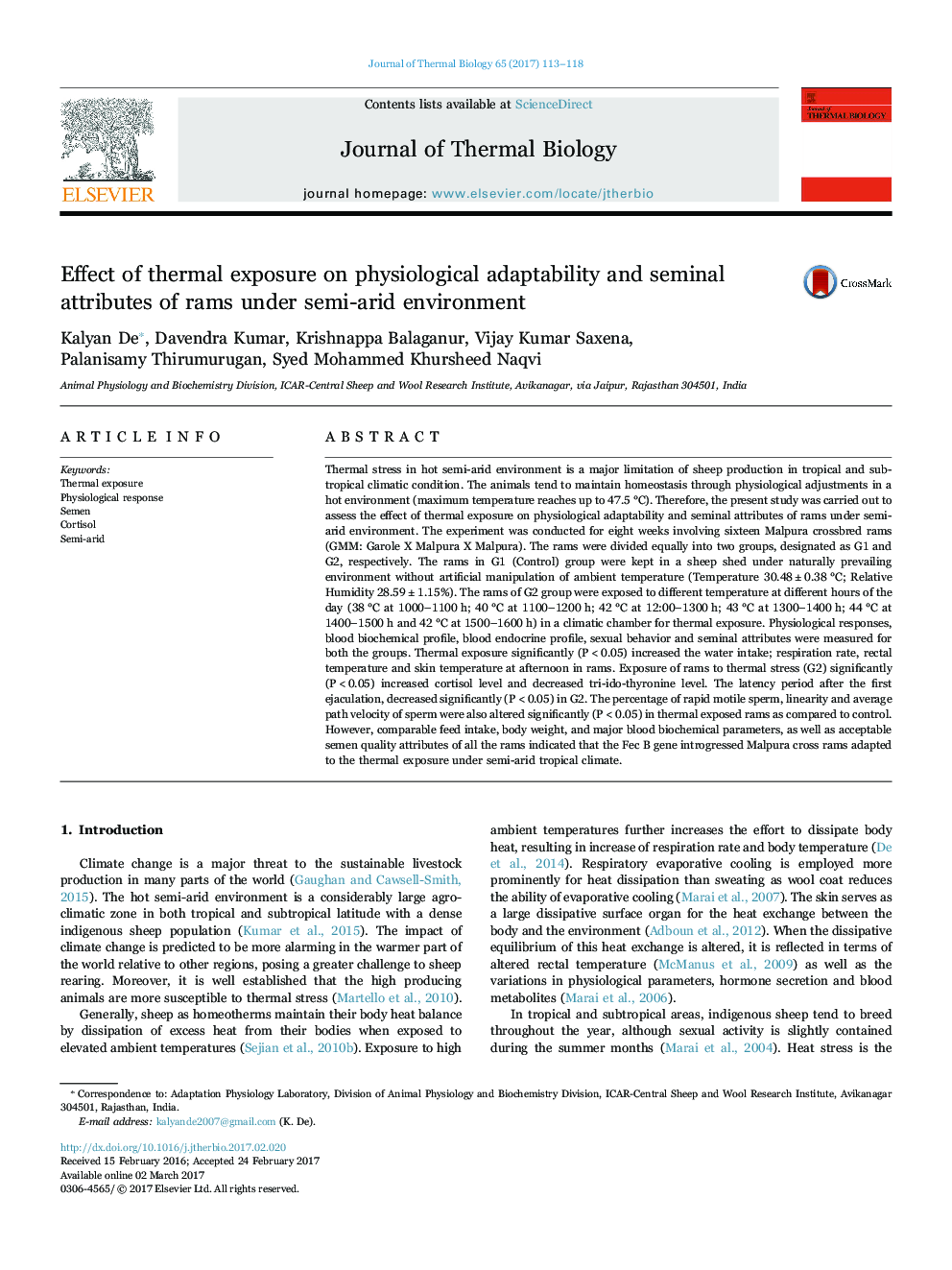| کد مقاله | کد نشریه | سال انتشار | مقاله انگلیسی | نسخه تمام متن |
|---|---|---|---|---|
| 5593405 | 1571082 | 2017 | 6 صفحه PDF | دانلود رایگان |
عنوان انگلیسی مقاله ISI
Effect of thermal exposure on physiological adaptability and seminal attributes of rams under semi-arid environment
ترجمه فارسی عنوان
اثر قرار گرفتن در معرض حرارتی بر سازگاری فیزیولوژیکی و ویژگی های ذاتی قوچ ها در محیط نیمه خشک
دانلود مقاله + سفارش ترجمه
دانلود مقاله ISI انگلیسی
رایگان برای ایرانیان
کلمات کلیدی
قرار گرفتن در معرض حرارت، پاسخ فیزیولوژیکی، اسپرم، کورتیزول، نیمه خشک،
موضوعات مرتبط
علوم زیستی و بیوفناوری
علوم کشاورزی و بیولوژیک
علوم کشاورزی و بیولوژیک (عمومی)
چکیده انگلیسی
Thermal stress in hot semi-arid environment is a major limitation of sheep production in tropical and sub-tropical climatic condition. The animals tend to maintain homeostasis through physiological adjustments in a hot environment (maximum temperature reaches up to 47.5 °C). Therefore, the present study was carried out to assess the effect of thermal exposure on physiological adaptability and seminal attributes of rams under semi-arid environment. The experiment was conducted for eight weeks involving sixteen Malpura crossbred rams (GMM: Garole X Malpura X Malpura). The rams were divided equally into two groups, designated as G1 and G2, respectively. The rams in G1 (Control) group were kept in a sheep shed under naturally prevailing environment without artificial manipulation of ambient temperature (Temperature 30.48±0.38 °C; Relative Humidity 28.59±1.15%). The rams of G2 group were exposed to different temperature at different hours of the day (38 °C at 1000-1100 h; 40 °C at 1100-1200 h; 42 °C at 12:00-1300 h; 43 °C at 1300-1400 h; 44 °C at 1400-1500 h and 42 °C at 1500-1600 h) in a climatic chamber for thermal exposure. Physiological responses, blood biochemical profile, blood endocrine profile, sexual behavior and seminal attributes were measured for both the groups. Thermal exposure significantly (P<0.05) increased the water intake; respiration rate, rectal temperature and skin temperature at afternoon in rams. Exposure of rams to thermal stress (G2) significantly (P<0.05) increased cortisol level and decreased tri-ido-thyronine level. The latency period after the first ejaculation, decreased significantly (P<0.05) in G2. The percentage of rapid motile sperm, linearity and average path velocity of sperm were also altered significantly (P<0.05) in thermal exposed rams as compared to control. However, comparable feed intake, body weight, and major blood biochemical parameters, as well as acceptable semen quality attributes of all the rams indicated that the Fec B gene introgressed Malpura cross rams adapted to the thermal exposure under semi-arid tropical climate.
ناشر
Database: Elsevier - ScienceDirect (ساینس دایرکت)
Journal: Journal of Thermal Biology - Volume 65, April 2017, Pages 113-118
Journal: Journal of Thermal Biology - Volume 65, April 2017, Pages 113-118
نویسندگان
Kalyan De, Davendra Kumar, Krishnappa Balaganur, Vijay Kumar Saxena, Palanisamy Thirumurugan, Syed Mohammed Khursheed Naqvi,
